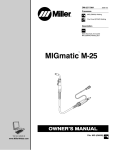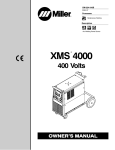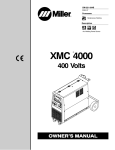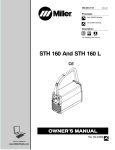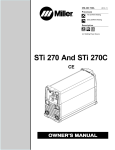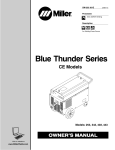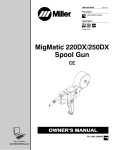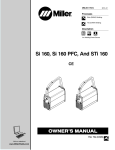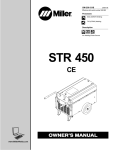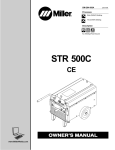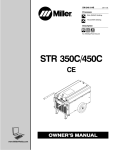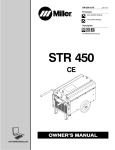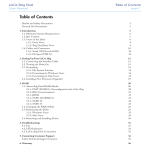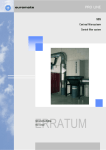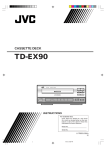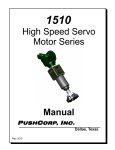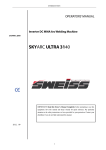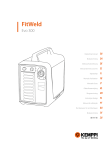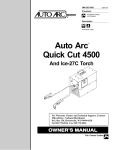Download Miller Hydracool 270 User Manual - Rapid Welding and Industrial
Transcript
OM-266 361A 2013−11 Processes TIG (GTAW) Welding MIG (GMAW) Welding Description Hydracool 270 CE OWNER’S MANUAL Visit our website at www.MillerWelds.com From Miller to You Thank you and congratulations on choosing Miller. Now you can get the job done and get it done right. We know you don’t have time to do it any other way. That’s why when Niels Miller first started building arc welders in 1929, he made sure his products offered long-lasting value and superior quality. Like you, his customers couldn’t afford anything less. Miller products had to be more than the best they could be. They had to be the best you could buy. Today, the people that build and sell Miller products continue the tradition. They’re just as committed to providing equipment and service that meets the high standards of quality and value established in 1929. This Owner’s Manual is designed to help you get the most out of your Miller products. Please take time to read the Safety precautions. They will help you protect yourself against potential hazards on the worksite. We’ve made installation and operation quick and easy. With Miller you can count on years of reliable service with proper maintenance. And if for some reason the unit needs repair, there’s a Troubleshooting section that will help you figure out what the problem is. The parts list will then help you to decide which exact part you may need to fix the problem. Warranty and service information for your particular model are also provided. Miller Electric manufactures a full line of welders and welding related equipment. For information on other quality Miller products, contact your local Miller distributor to receive the latest full line catalog or individual catalog sheets. Working as hard as you do − every power source from Miller is backed by the most hassle-free warranty in the business. TABLE OF CONTENTS SECTION 1 − SAFETY PRECAUTIONS - READ BEFORE USING . . . . . . . . . . . . . . . . . . . . . . . . . . . . . . . . . 1-1. Symbol Usage . . . . . . . . . . . . . . . . . . . . . . . . . . . . . . . . . . . . . . . . . . . . . . . . . . . . . . . . . . . . . . . . . . . . . . . 1-2. Arc Welding Hazards . . . . . . . . . . . . . . . . . . . . . . . . . . . . . . . . . . . . . . . . . . . . . . . . . . . . . . . . . . . . . . . . . 1-3. Additional Symbols For Installation, Operation, And Maintenance . . . . . . . . . . . . . . . . . . . . . . . . . . . . . 1-4. California Proposition 65 Warnings . . . . . . . . . . . . . . . . . . . . . . . . . . . . . . . . . . . . . . . . . . . . . . . . . . . . . . 1-5. Principal Safety Standards . . . . . . . . . . . . . . . . . . . . . . . . . . . . . . . . . . . . . . . . . . . . . . . . . . . . . . . . . . . . . 1-6. EMF Information . . . . . . . . . . . . . . . . . . . . . . . . . . . . . . . . . . . . . . . . . . . . . . . . . . . . . . . . . . . . . . . . . . . . . SECTION 2 − DEFINITIONS . . . . . . . . . . . . . . . . . . . . . . . . . . . . . . . . . . . . . . . . . . . . . . . . . . . . . . . . . . . . . . . . . . 2-1. Additional Safety Symbols And Definitions . . . . . . . . . . . . . . . . . . . . . . . . . . . . . . . . . . . . . . . . . . . . . . . . 2-2. Miscellaneous Symbols And Definitions . . . . . . . . . . . . . . . . . . . . . . . . . . . . . . . . . . . . . . . . . . . . . . . . . . SECTION 3 − SPECIFICATIONS . . . . . . . . . . . . . . . . . . . . . . . . . . . . . . . . . . . . . . . . . . . . . . . . . . . . . . . . . . . . . . 3-1. Important Information Regarding CE Products (Sold Within The EU) . . . . . . . . . . . . . . . . . . . . . . . . . . 3-2. Serial Number And Rating Label Location . . . . . . . . . . . . . . . . . . . . . . . . . . . . . . . . . . . . . . . . . . . . . . . . 3-3. Specifications* . . . . . . . . . . . . . . . . . . . . . . . . . . . . . . . . . . . . . . . . . . . . . . . . . . . . . . . . . . . . . . . . . . . . . . . 3-4. Environmental Specifications . . . . . . . . . . . . . . . . . . . . . . . . . . . . . . . . . . . . . . . . . . . . . . . . . . . . . . . . . . . 3-5. Coolant Chart . . . . . . . . . . . . . . . . . . . . . . . . . . . . . . . . . . . . . . . . . . . . . . . . . . . . . . . . . . . . . . . . . . . . . . . . SECTION 4 − INSTALLATION . . . . . . . . . . . . . . . . . . . . . . . . . . . . . . . . . . . . . . . . . . . . . . . . . . . . . . . . . . . . . . . . 4-1. Selecting a Location . . . . . . . . . . . . . . . . . . . . . . . . . . . . . . . . . . . . . . . . . . . . . . . . . . . . . . . . . . . . . . . . . . 4-2. Installing Unit On A STH 270 Welding Power Source And Connecting 400 VAC Input Power . . . . . . SECTION 5 − OPERATION . . . . . . . . . . . . . . . . . . . . . . . . . . . . . . . . . . . . . . . . . . . . . . . . . . . . . . . . . . . . . . . . . . . 5-1. Control Panel . . . . . . . . . . . . . . . . . . . . . . . . . . . . . . . . . . . . . . . . . . . . . . . . . . . . . . . . . . . . . . . . . . . . . . . . SECTION 6 − MAINTENANCE & TROUBLESHOOTING . . . . . . . . . . . . . . . . . . . . . . . . . . . . . . . . . . . . . . . . . 6-1. Routine Maintenance . . . . . . . . . . . . . . . . . . . . . . . . . . . . . . . . . . . . . . . . . . . . . . . . . . . . . . . . . . . . . . . . . 6-2. Coolant Maintenance . . . . . . . . . . . . . . . . . . . . . . . . . . . . . . . . . . . . . . . . . . . . . . . . . . . . . . . . . . . . . . . . . 6-3. Flow Direction . . . . . . . . . . . . . . . . . . . . . . . . . . . . . . . . . . . . . . . . . . . . . . . . . . . . . . . . . . . . . . . . . . . . . . . 6-4. Troubleshooting . . . . . . . . . . . . . . . . . . . . . . . . . . . . . . . . . . . . . . . . . . . . . . . . . . . . . . . . . . . . . . . . . . . . . . SECTION 7 − ELECTRICAL DIAGRAM . . . . . . . . . . . . . . . . . . . . . . . . . . . . . . . . . . . . . . . . . . . . . . . . . . . . . . . . SECTION 8 − PARTS LIST . . . . . . . . . . . . . . . . . . . . . . . . . . . . . . . . . . . . . . . . . . . . . . . . . . . . . . . . . . . . . . . . . . . WARRANTY 1 1 1 3 4 4 4 5 5 6 7 7 7 7 7 8 8 8 9 10 10 11 11 11 12 12 13 14 DECLARATION OF CONFORMITY for European Community (CE marked) products. ITW Welding Italy S.r.l Via Privata Iseo 6/E, 20098 San Giuliano M.se, (MI) Italy declares that the prod uct(s) identified in this declaration conform to the essential requirements and provisions of the stat ed Council Directive(s) and Standard(s). Product/Apparatus Identification: Product Stock Number HYDRACOOL 270 028042107 Council Directives: ·2006/95/EC Low Voltage ·2004/108/EC Electromagnetic Compatibility ·2011/65/EU Restriction of the use of certain hazardous substances in electrical and electronic equipment Standards: ·IEC 609741 Arc Welding Equipment Welding Power Sources: edition 3, 200507. ·IEC 609742 Arc Welding Equipment – Liquid Cooling Systems: edition 2.0, 200711. ·IEC 6097410 Arc Welding Equipment Electromagnetic Compatibility Requirements: edition 2.0, 200708. ·EN 50445:2008 Product family standard to demonstrate compliance of equipment for resistance welding, arc weld ing and allied processes with the basic restrictions related to human exposure to electromagnetic fields (0Hz300Hz) EU Signatory: November 15th , 2013 ___________________________________________________________________________________ Massimigliano Lavarini Date of Declaration ELECTRONIC ENGINEER R&D TECH. SUPPORT 956 172 141 SECTION 1 − SAFETY PRECAUTIONS - READ BEFORE USING som 2013−09 7 Protect yourself and others from injury — read, follow, and save these important safety precautions and operating instructions. 1-1. Symbol Usage DANGER! − Indicates a hazardous situation which, if not avoided, will result in death or serious injury. The possible hazards are shown in the adjoining symbols or explained in the text. Indicates a hazardous situation which, if not avoided, could result in death or serious injury. The possible hazards are shown in the adjoining symbols or explained in the text. NOTICE − Indicates statements not related to personal injury. Indicates special instructions. This group of symbols means Warning! Watch Out! ELECTRIC SHOCK, MOVING PARTS, and HOT PARTS hazards. Consult symbols and related instructions below for necessary actions to avoid the hazards. 1-2. Arc Welding Hazards The symbols shown below are used throughout this manual to call attention to and identify possible hazards. When you see the symbol, watch out, and follow the related instructions to avoid the hazard. The safety information given below is only a summary of the more complete safety information found in the Safety Standards listed in Section 1-5. Read and follow all Safety Standards. Only qualified persons should install, operate, maintain, and repair this unit. During operation, keep everybody, especially children, away. ELECTRIC SHOCK can kill. Touching live electrical parts can cause fatal shocks or severe burns. The electrode and work circuit is electrically live whenever the output is on. The input power circuit and machine internal circuits are also live when power is on. In semiautomatic or automatic wire welding, the wire, wire reel, drive roll housing, and all metal parts touching the welding wire are electrically live. Incorrectly installed or improperly grounded equipment is a hazard. Do not touch live electrical parts. Wear dry, hole-free insulating gloves and body protection. Insulate yourself from work and ground using dry insulating mats or covers big enough to prevent any physical contact with the work or ground. Do not use AC output in damp areas, if movement is confined, or if there is a danger of falling. Use AC output ONLY if required for the welding process. If AC output is required, use remote output control if present on unit. Additional safety precautions are required when any of the following electrically hazardous conditions are present: in damp locations or while wearing wet clothing; on metal structures such as floors, gratings, or scaffolds; when in cramped positions such as sitting, kneeling, or lying; or when there is a high risk of unavoidable or accidental contact with the workpiece or ground. For these conditions, use the following equipment in order presented: 1) a semiautomatic DC constant voltage (wire) welder, 2) a DC manual (stick) welder, or 3) an AC welder with reduced open-circuit voltage. In most situations, use of a DC, constant voltage wire welder is recommended. And, do not work alone! Disconnect input power or stop engine before installing or servicing this equipment. Lockout/tagout input power according to OSHA 29 CFR 1910.147 (see Safety Standards). Properly install, ground, and operate this equipment according to its Owner’s Manual and national, state, and local codes. Always verify the supply ground − check and be sure that input power cord ground wire is properly connected to ground terminal in disconnect box or that cord plug is connected to a properly grounded receptacle outlet. When making input connections, attach proper grounding conductor first − double-check connections. Keep cords dry, free of oil and grease, and protected from hot metal and sparks. Frequently inspect input power cord and ground conductor for damage or bare wiring – replace immediately if damaged – bare wiring can kill. Turn off all equipment when not in use. Do not use worn, damaged, undersized, or repaired cables. Do not drape cables over your body. If earth grounding of the workpiece is required, ground it directly with a separate cable. Do not touch electrode if you are in contact with the work, ground, or another electrode from a different machine. Do not touch electrode holders connected to two welding machines at the same time since double open-circuit voltage will be present. Use only well-maintained equipment. Repair or replace damaged parts at once. Maintain unit according to manual. Wear a safety harness if working above floor level. Keep all panels and covers securely in place. Clamp work cable with good metal-to-metal contact to workpiece or worktable as near the weld as practical. Insulate work clamp when not connected to workpiece to prevent contact with any metal object. Do not connect more than one electrode or work cable to any single weld output terminal. Disconnect cable for process not in use. Use GFCI protection when operating auxiliary equipment in damp or wet locations. SIGNIFICANT DC VOLTAGE exists in inverter welding power sources AFTER removal of input power. Turn Off inverter, disconnect input power, and discharge input capacitors according to instructions in Maintenance Section before touching any parts. HOT PARTS can burn. Do not touch hot parts bare handed. Allow cooling period before working on equipment. To handle hot parts, use proper tools and/or wear heavy, insulated welding gloves and clothing to prevent burns. OM-266 361 Page 1 FUMES AND GASES can be hazardous. Welding produces fumes and gases. Breathing these fumes and gases can be hazardous to your health. Keep your head out of the fumes. Do not breathe the fumes. If inside, ventilate the area and/or use local forced ventilation at the arc to remove welding fumes and gases. The recommended way to determine adequate ventilation is to sample for the composition and quantity of fumes and gases to which personnel are exposed. If ventilation is poor, wear an approved air-supplied respirator. Read and understand the Safety Data Sheets (SDSs) and the manufacturer’s instructions for adhesives, coatings, cleaners, consumables, coolants, degreasers, fluxes, and metals. Work in a confined space only if it is well ventilated, or while wearing an air-supplied respirator. Always have a trained watchperson nearby. Welding fumes and gases can displace air and lower the oxygen level causing injury or death. Be sure the breathing air is safe. Do not weld in locations near degreasing, cleaning, or spraying operations. The heat and rays of the arc can react with vapors to form highly toxic and irritating gases. Do not weld on coated metals, such as galvanized, lead, or cadmium plated steel, unless the coating is removed from the weld area, the area is well ventilated, and while wearing an air-supplied respirator. The coatings and any metals containing these elements can give off toxic fumes if welded. ARC RAYS can burn eyes and skin. Arc rays from the welding process produce intense visible and invisible (ultraviolet and infrared) rays that can burn eyes and skin. Sparks fly off from the weld. Wear an approved welding helmet fitted with a proper shade of filter lenses to protect your face and eyes from arc rays and sparks when welding or watching (see ANSI Z49.1 and Z87.1 listed in Safety Standards). Wear approved safety glasses with side shields under your helmet. Use protective screens or barriers to protect others from flash, glare and sparks; warn others not to watch the arc. Wear body protection made from durable, flame−resistant material (leather, heavy cotton, wool). Body protection includes oil-free clothing such as leather gloves, heavy shirt, cuffless trousers, high shoes, and a cap. WELDING can cause fire or explosion. Welding on closed containers, such as tanks, drums, or pipes, can cause them to blow up. Sparks can fly off from the welding arc. The flying sparks, hot workpiece, and hot equipment can cause fires and burns. Accidental contact of electrode to metal objects can cause sparks, explosion, overheating, or fire. Check and be sure the area is safe before doing any welding. Remove all flammables within 35 ft (10.7 m) of the welding arc. If this is not possible, tightly cover them with approved covers. Do not weld where flying sparks can strike flammable material. Protect yourself and others from flying sparks and hot metal. Be alert that welding sparks and hot materials from welding can easily go through small cracks and openings to adjacent areas. Watch for fire, and keep a fire extinguisher nearby. Be aware that welding on a ceiling, floor, bulkhead, or partition can cause fire on the hidden side. Do not weld on containers that have held combustibles, or on closed containers such as tanks, drums, or pipes unless they are properly prepared according to AWS F4.1 and AWS A6.0 (see Safety Standards). Do not weld where the atmosphere may contain flammable dust, gas, or liquid vapors (such as gasoline). Connect work cable to the work as close to the welding area as practical to prevent welding current from traveling long, possibly unknown paths and causing electric shock, sparks, and fire hazards. Do not use welder to thaw frozen pipes. OM-266 361 Page 2 Remove stick electrode from holder or cut off welding wire at contact tip when not in use. Wear body protection made from durable, flame−resistant material (leather, heavy cotton, wool). Body protection includes oil-free clothing such as leather gloves, heavy shirt, cuffless trousers, high shoes, and a cap. Remove any combustibles, such as a butane lighter or matches, from your person before doing any welding. After completion of work, inspect area to ensure it is free of sparks, glowing embers, and flames. Use only correct fuses or circuit breakers. Do not oversize or bypass them. Follow requirements in OSHA 1910.252 (a) (2) (iv) and NFPA 51B for hot work and have a fire watcher and extinguisher nearby. Read and understand the Safety Data Sheets (SDSs) and the manufacturer s instructions for adhesives, coatings, cleaners, consumables, coolants, degreasers, fluxes, and metals. FLYING METAL or DIRT can injure eyes. Welding, chipping, wire brushing, and grinding cause sparks and flying metal. As welds cool, they can throw off slag. Wear approved safety glasses with side shields even under your welding helmet. BUILDUP OF GAS can injure or kill. Shut off compressed gas supply when not in use. Always ventilate confined spaces or use approved air-supplied respirator. ELECTRIC AND MAGNETIC FIELDS (EMF) can affect Implanted Medical Devices. Wearers of Pacemakers and other Implanted Medical Devices should keep away. Implanted Medical Device wearers should consult their doctor and the device manufacturer before going near arc welding, spot welding, gouging, plasma arc cutting, or induction heating operations. NOISE can damage hearing. Noise from some processes or equipment can damage hearing. Wear approved ear protection if noise level is high. CYLINDERS can explode if damaged. Compressed gas cylinders contain gas under high pressure. If damaged, a cylinder can explode. Since gas cylinders are normally part of the welding process, be sure to treat them carefully. Protect compressed gas cylinders from excessive heat, mechanical shocks, physical damage, slag, open flames, sparks, and arcs. Install cylinders in an upright position by securing to a stationary support or cylinder rack to prevent falling or tipping. Keep cylinders away from any welding or other electrical circuits. Never drape a welding torch over a gas cylinder. Never allow a welding electrode to touch any cylinder. Never weld on a pressurized cylinder − explosion will result. Use only correct compressed gas cylinders, regulators, hoses, and fittings designed for the specific application; maintain them and associated parts in good condition. Turn face away from valve outlet when opening cylinder valve. Do not stand in front of or behind the regulator when opening the valve. Keep protective cap in place over valve except when cylinder is in use or connected for use. Use the right equipment, correct procedures, and sufficient number of persons to lift and move cylinders. Read and follow instructions on compressed gas cylinders, associated equipment, and Compressed Gas Association (CGA) publication P-1 listed in Safety Standards. 1-3. Additional Symbols For Installation, Operation, And Maintenance FIRE OR EXPLOSION hazard. Do not install or place unit on, over, or near combustible surfaces. Do not install unit near flammables. Do not overload building wiring − be sure power supply system is properly sized, rated, and protected to handle this unit. FALLING EQUIPMENT can injure. Use lifting eye to lift unit only, NOT running gear, gas cylinders, or any other accessories. Use equipment of adequate capacity to lift and support unit. If using lift forks to move unit, be sure forks are long enough to extend beyond opposite side of unit. Keep equipment (cables and cords) away from moving vehicles when working from an aerial location. Follow the guidelines in the Applications Manual for the Revised NIOSH Lifting Equation (Publication No. 94−110) when manually lifting heavy parts or equipment. OVERUSE can cause OVERHEATING MOVING PARTS can injure. Keep away from moving parts such as fans. Keep all doors, panels, covers, and guards closed and securely in place. Have only qualified persons remove doors, panels, covers, or guards for maintenance and troubleshooting as necessary. Reinstall doors, panels, covers, or guards when maintenance is finished and before reconnecting input power. READ INSTRUCTIONS. Read and follow all labels and the Owner’s Manual carefully before installing, operating, or servicing unit. Read the safety information at the beginning of the manual and in each section. Use only genuine replacement parts from the manufacturer. Perform maintenance and service according to the Owner’s Manuals, industry standards, and national, state, and local codes. Allow cooling period; follow rated duty cycle. Reduce current or reduce duty cycle before starting to weld again. Do not block or filter airflow to unit. H.F. RADIATION can cause interference. FLYING SPARKS can injure. Wear a face shield to protect eyes and face. Shape tungsten electrode only on grinder with proper guards in a safe location wearing proper face, hand, and body protection. Sparks can cause fires — keep flammables away. STATIC (ESD) can damage PC boards. Put on grounded wrist strap BEFORE handling boards or parts. Use proper static-proof bags and boxes to store, move, or ship PC boards. High-frequency (H.F.) can interfere with radio navigation, safety services, computers, and communications equipment. Have only qualified persons familiar with electronic equipment perform this installation. The user is responsible for having a qualified electrician promptly correct any interference problem resulting from the installation. If notified by the FCC about interference, stop using the equipment at once. Have the installation regularly checked and maintained. Keep high-frequency source doors and panels tightly shut, keep spark gaps at correct setting, and use grounding and shielding to minimize the possibility of interference. MOVING PARTS can injure. ARC WELDING can cause interference. Keep away from moving parts. Keep away from pinch points such as drive rolls. WELDING WIRE can injure. Do not press gun trigger until instructed to do so. Do not point gun toward any part of the body, other people, or any metal when threading welding wire. BATTERY EXPLOSION can injure. Do not use welder to charge batteries or jump start vehicles unless it has a battery charging feature designed for this purpose. Electromagnetic energy can interfere with sensitive electronic equipment such as computers and computer-driven equipment such as robots. Be sure all equipment in the welding area is electromagnetically compatible. To reduce possible interference, keep weld cables as short as possible, close together, and down low, such as on the floor. Locate welding operation 100 meters from any sensitive electronic equipment. Be sure this welding machine is installed and grounded according to this manual. If interference still occurs, the user must take extra measures such as moving the welding machine, using shielded cables, using line filters, or shielding the work area. OM-266 361 Page 3 1-4. California Proposition 65 Warnings Welding or cutting equipment produces fumes or gases which contain chemicals known to the State of California to cause birth defects and, in some cases, cancer. (California Health & Safety Code Section 25249.5 et seq.) This product contains chemicals, including lead, known to the state of California to cause cancer, birth defects, or other reproductive harm. Wash hands after use. 1-5. Principal Safety Standards Safety in Welding, Cutting, and Allied Processes, ANSI Standard Z49.1, is available as a free download from the American Welding Society at http://www.aws.org or purchased from Global Engineering Documents (phone: 1-877-413-5184, website: www.global.ihs.com). Safe Practices for the Preparation of Containers and Piping for Welding and Cutting, American Welding Society Standard AWS F4.1, from Global Engineering Documents (phone: 1-877-413-5184, website: www.global.ihs.com). Safe Practices for Welding and Cutting Containers that have Held Combustibles, American Welding Society Standard AWS A6.0, from Global Engineering Documents (phone: 1-877-413-5184, website: www.global.ihs.com). National Electrical Code, NFPA Standard 70, from National Fire Protection Association, Quincy, MA 02269 (phone: 1-800-344-3555, website: www.nfpa.org and www. sparky.org). Safe Handling of Compressed Gases in Cylinders, CGA Pamphlet P-1, from Compressed Gas Association, 14501 George Carter Way, Suite 103, Chantilly, VA 20151 (phone: 703-788-2700, website:www.cganet.com). Safety in Welding, Cutting, and Allied Processes, CSA Standard W117.2, from Canadian Standards Association, Standards Sales, 5060 Spectrum Way, Suite 100, Ontario, Canada L4W 5NS (phone: 800-463-6727, website: www.csa-international.org). Safe Practice For Occupational And Educational Eye And Face Protection, ANSI Standard Z87.1, from American National Standards Institute, 25 West 43rd Street, New York, NY 10036 (phone: 212-642-4900, website: www.ansi.org). Standard for Fire Prevention During Welding, Cutting, and Other Hot Work, NFPA Standard 51B, from National Fire Protection Association, Quincy, MA 02269 (phone: 1-800-344-3555, website: www.nfpa.org. OSHA, Occupational Safety and Health Standards for General Industry, Title 29, Code of Federal Regulations (CFR), Part 1910, Subpart Q, and Part 1926, Subpart J, from U.S. Government Printing Office, Superintendent of Documents, P.O. Box 371954, Pittsburgh, PA 15250-7954 (phone: 1-866-512-1800) (there are 10 OSHA Regional Offices— phone for Region 5, Chicago, is 312-353-2220, website: www.osha.gov). Applications Manual for the Revised NIOSH Lifting Equation, The National Institute for Occupational Safety and Health (NIOSH), 1600 Clifton Rd, Atlanta, GA 30333 (phone: 1-800-232-4636, website: www.cdc.gov/NIOSH). 1-6. EMF Information Electric current flowing through any conductor causes localized electric and magnetic fields (EMF). The current from arc welding (and allied processes including spot welding, gouging, plasma arc cutting, and induction heating operations) creates an EMF field around the welding circuit. EMF fields may interfere with some medical implants, e.g. pacemakers. Protective measures for persons wearing medical implants have to be taken. For example, restrict access for passers−by or conduct individual risk assessment for welders. All welders should use the following procedures in order to minimize exposure to EMF fields from the welding circuit: 1. Keep cables close together by twisting or taping them, or using a cable cover. 2. Do not place your body between welding cables. Arrange cables to one side and away from the operator. 3. Do not coil or drape cables around your body. OM-266 361 Page 4 4. Keep head and trunk as far away from the equipment in the welding circuit as possible. 5. Connect work clamp to workpiece as close to the weld as possible. 6. Do not work next to, sit or lean on the welding power source. 7. Do not weld whilst carrying the welding power source or wire feeder. About Implanted Medical Devices: Implanted Medical Device wearers should consult their doctor and the device manufacturer before performing or going near arc welding, spot welding, gouging, plasma arc cutting, or induction heating operations. If cleared by your doctor, then following the above procedures is recommended. SECTION 2 − DEFINITIONS 2-1. Additional Safety Symbols And Definitions Some symbols are found only on CE products. Warning! Watch Out! There are possible hazards as shown by the symbols. Safe1 2012−05 Do not discard product (where applicable) with general waste. Reuse or recycle Waste Electrical and Electronic Equipment (WEEE) by disposing at a designated collection facility. Contact your local recycling office or your local distributor for further information. Safe37 2012−05 Disconnect input plug or power before working on machine. Safe5 2012−05 Do not remove or paint over (cover) the label. Safe20 2012−05 Recycle. Safe103 2012−09 Use coolant suggested by the manufacturer. XXXXX Safe52 2012−05 Please drain fluid according to instructions. 2012−05 Read the labels on the welding power source, wire feeder, or other major equipment for welding safety information. Safe71 2012−06 Read the Owner’s Manual before working on this machine. Safe70 2012−06 OM-266 361 Page 5 Plugged filter or hoses can cause overheating to the power source and torch. Safe50 2012−05 100 h. Std. Every 100 hours, check and clean filter and check condition of hoses. Safe51 2012−05 2-2. Miscellaneous Symbols And Definitions A V Amperes Alternating Current Voltage Input Circulating Unit With Coolant Pump Volts Water (Coolant) Input Water (Coolant) Output Line Connection Protective Earth (Ground) On Notes OM-266 361 Page 6 IP Degree Of Protection Off I1 U1 Primary Current Primary Voltage Hz Hertz Single Phase SECTION 3 − SPECIFICATIONS 3-1. Important Information Regarding CE Products (Sold Within The EU) ! This equipment shall not be used by the general public as the EMF limits for the general public might be exceeded during welding. This equipment is built in accordance with EN 60974−1 and is intended to be used only in an occupational environment (where the general public access is prohibited or regulated in such a way as to be similar to occupational use) by an expert or an instructed person. Wire feeders and ancillary equipment (such as torches, liquid cooling systems and arc striking and stabilizing devices) as part of the welding circuit may not be a major contributor to the EMF. See the Owner’s Manuals for all components of the welding circuit for additional EMF exposure information. The EMF assessment on this equipment was conducted at 0.5 meter. At a distance of 1 meter the EMF exposure values were less than 20% of the permissible values. ce-emf 1 2010-10 3-2. Serial Number And Rating Label Location The serial number and rating information for this product is located on the back panel. Use rating label to determine input power requirements and/or rated output. For future reference, write serial number in space provided on cover of this manual. 3-3. Specifications* Model Coolant Tank Capacity Maximum Cooling Capacity Input Power Dimensions Weight Hydracool 270 5L 1470 Watts (5020 BTU/hr) 1.0 L/min (1.1 qt/min) Three Phase 400 VAC 50/60 Hz 0.5 Amperes Length: 620 mm Height: 320 mm Width: 227 mm 23.2 kg *IEC Cooling Capacity States That The Water Inlet Temperature Can Not Exceed 40° C Above Ambient Temperature At A 1l/ Min Flow Rate. **Plug Is Customer Supplied. Recirculating Coolant System For Water-Cooled GTAW Torches And GMAW Guns. Use With Guns/Torches Rated Up To 280 Amperes 3-4. Environmental Specifications IP Rating Operating Temperature Range Storage Temperature Range −10 to 40°C (14 to 104 °F) 20 to 25°C (68 to 77 °F) Hydracool 270 − IP23S This equipment is designed for outdoor use. It may be stored, but is not intended to be used outside during precipitation unless sheltered. OM-266 361 Page 7 3-5. Coolant Chart GTAW Or Where HF* Is Used GMAW Or Where HF* Is Not Used Where Coolant Contacts Aluminum Parts MILLER Low Conductivity Coolant No. 043 810**; Distilled Or Deionized Water OK Above 32° F (0° C) MILLER Low Conductivity Coolant No. 043 810**; Or MILLER Aluminum Protecting Coolant No. 043 809**; Distilled Or Deionized Water OK Above 32° F (0° C) MILLER Aluminum Protecting Coolant No. 043 809** Application Coolant *HF: High Frequency Current **MILLER coolants protect to -37° F (-38°C) and resist algae growth. NOTICE − Use of any coolant other than those listed in the table voids the warranty on any parts that come in contact with the coolant (pump, radiator, etc.). Ref. 956142645-4-5 SECTION 4 − INSTALLATION 4-1. Selecting a Location Position unit so air can circulate. 500 mm 500 mm 500 mm 956172138_1-A OM-266 361 Page 8 4-2. Installing Unit On A STH 270 Welding Power Source And Connecting 400 VAC Input Power 2 1 Welding Power Source ! Have only qualified persons make this installation. ! Disconnect and lockout/tagout input power before connecting input conductors from unit. Follow established procedures regarding the installation and removal of lockout/tagout devices. 2 3 4 5 6 Front/Rear Bezel Mounting Brackets Screws Plastic Cap Wrapper 4 1 6 3 Loosen screws and remove bezels. Install cooling system on power source by checking that mounting holes match. Reinstall bezels. Do not fully tighten screws. Remove wrapper from power source and plastic cap from power source rear panel. Cooling Supply Circuit Board 7 8 12 Strain Relief Input Power Cord Insert strain relief into hole. Route power cord through strain relief and tighten strain relief. 5 ! 11 8 10 9 Always connect green or green/yellow conductor to supply grounding terminal first, and never to a line terminal. 9 Machine Grounding Terminal 10 Green/Yellow Grounding Conductor 11 Input Conductors (L1, L2) 12 Device Line Terminals 7 10 11 Secure grounding conductor to machine grounding terminal first. Connect input conductors L1, L2 to device line terminals. Reinstall wrapper. Close and secure door on disconnect device. Follow established lockout/tagout procedures to put unit in service. Tools Needed: Torx T20 956172138_2-A OM-266 361 Page 9 SECTION 5 − OPERATION 5-1. Control Panel 1 2 1 2 3 4 Front 5 3 4 5 6 6 Tank Filler Neck Supplementary Protector (CB1) Power On/Off Light Quick Connect; Water Out Quick Connect; Water In Power On/Off Switch Back 956172138_3-A OM-266 361 Page 10 SECTION 6 − MAINTENANCE & TROUBLESHOOTING 6-1. Routine Maintenance ! = Check = Change = Clean * To be done by Factory Authorized Service Agent Every 3 Months Disconnect power before maintaining. = Replace Reference NOTICE − Clean coolant filter. Severe conditions may require more frequent cleaning (continuous use, high/low temperatures, dirty environment, etc.). Failure to properly clean coolant filter voids pump warranty. Coolant Filter Every 6 Months Cracked Parts Change Coolant (If Using Water) Replace Unreadable Labels Every 12 Months Change Coolant (If Using (B)050024004) 6-2. Coolant Maintenance 2 ! Turn off welding power source before maintaining. 1 Cooler Side Panel 2 Coolant Level Indicator 3 Coolant Filter Unscrew housing to clean filter and housing. 1 Changing coolant: Drain coolant by tipping unit forward. Fill with clean water and run for 10 minutes. Drain and refill. If 3 replacing hoses, use hoses compatible with ethylene glycol, such as Buna-n, Neoprene, or Hypalon. Oxy-acetylene hoses are not compatible with any product containing ethylene glycol. 956172138_4-A OM-266 361 Page 11 6-3. Flow Direction Blue Outlet Flow Filter Inlet Flow Red Tank Radiator 956172140-A 6-4. Troubleshooting Trouble Coolant system does not work. Remedy Be sure cooler input power and communication cables from power source are connected to cooler receptacles. Check input power line fuses or circuit breaker, and replace or reset if necessary. Have Factory Authorized Service Agent check motor. Decreased or no coolant flow. Add coolant. Check for clogged hoses or coolant filter. Clean filter or clean / replace hoses if necessary. Disconnect pump, and check for sheared coupling. Replace coupling if necessary. OM-266 361 Page 12 SECTION 7 − ELECTRICAL DIAGRAM 956172139_A OM-266 361 Page 13 SECTION 8 − PARTS LIST Hardware is common and not available unless listed. 2 29 1 2 29 30 31 15 14 8 9 10 3 13 7 12 4 6 11 5 16 17 28 18 19 22 23 25 16 32 24 26 27 21 20 956172138_5-A Figure 8-1. Main Assembly, Hydracool 270 OM-266 361 Page 14 Item No. Dia. Mkgs. Part No. Description Figure 8-1. Main Assembly, Hydracool 1 . . . 1 . . . . . . . . +116121128 . . . 2 . . . . . . . . . 156005187 . . . 3 . . . . . . . . . . . . . 166564 . . . 4 . . . . . . . . . . . . . 235419 . . . 5 . . . . . . . . . . . . . 166608 . . . 6 . . . . . . . . . . . . . 251119 . . . 7 . . MOT 057010060 . . . 8 . . . . . . . . . 556049386 . . . 9 . . . . . . . . . 556049419 . . . 10 . . . . . . . . . V57011071 . . . 11 . . . . . . . . . 156005186 . . . 12 . . . . T1 . 058021161 . . . 13 . . . . . . . . . 056082104 . . . 14 . . . . . . . . +156005188 . . . 15 . . . FM . . . . 235504 . . . 16 . . . . . . . . . . . . . 251125 . . . 17 . . . . . . . . . 057014280 . . . 18 . . . . . . . . . 756007013 . . 19 . . . S1 . 056067251 . . . 20 . . . . . . . . . . 656110013 . . . 21 . . . . . . . . . . 116006132 . . . 22 . . . CB1 . . . . 083431 . . . 23 . . . . . . . . . 556049410 . . . 24 . . . . . . . . . 556049409 . . . 25 . . . . . . . . . 316029728 . . . 26 . . . PL1 . 056072084 . . . 27 . . . . . . . . . 156033034 . . . 28 . . . . . . . . . 316029729 . . . 29 . . . . . . . . . . . . . 180663 . . . 30 . . . . . . . . . . . . . 207290 . . . 31 . . . . . . . . . 956142629 . . . 32 . . . . . . . . . . . . . 155436 .. .. .. .. .. .. .. .. .. .. .. .. .. .. .. .. .. .. .. .. .. .. .. .. .. .. .. .. .. .. .. .. Wrapper . . . . . . . . . . . . . . . . . . . . . . . . . . . . . . . . . . . . . . . . . . . . . . . . . . . . . . . Bracket, Mtg Welding Power Supply . . . . . . . . . . . . . . . . . . . . . . . . . . . . Filter, In−Line Low Profile 100 Screen 3/8 Hose Bar . . . . . . . . . . . . . Bracket, Filter . . . . . . . . . . . . . . . . . . . . . . . . . . . . . . . . . . . . . . . . . . . . . . . . . Cap, Tank Screw . . . . . . . . . . . . . . . . . . . . . . . . . . . . . . . . . . . . . . . . . . Tank, Water 5 L . . . . . . . . . . . . . . . . . . . . . . . . . . . . . . . . . . . . . . . . . . . . Motor, 170 W, 230 VAC . . . . . . . . . . . . . . . . . . . . . . . . . . . . . . . . . . . . . Connector, Male 3/8 D.10 . . . . . . . . . . . . . . . . . . . . . . . . . . . . . . . . . . . Elbow Pipe, Male/Female 3/8 . . . . . . . . . . . . . . . . . . . . . . . . . . . . . . . Pump Assy . . . . . . . . . . . . . . . . . . . . . . . . . . . . . . . . . . . . . . . . . . . . . . . . Mtg Bracket, Motor & Transformer . . . . . . . . . . . . . . . . . . . . . . . . . . . Transformer, 400/230 VAC . . . . . . . . . . . . . . . . . . . . . . . . . . . . . . . . . . Radiator Assy . . . . . . . . . . . . . . . . . . . . . . . . . . . . . . . . . . . . . . . . . . . . . Fan Support . . . . . . . . . . . . . . . . . . . . . . . . . . . . . . . . . . . . . . . . . . . . . . . Fan Assy, Radiator Cooling 230 V . . . . . . . . . . . . . . . . . . . . . . . . . . . Bezel, Front/Rear . . . . . . . . . . . . . . . . . . . . . . . . . . . . . . . . . . . . . . . . . . Cable, Primary, 400 VAC C/W Strain Relief . . . . . . . . . . . . . . . . . . . . Cover, Switch 37 X 20 . . . . . . . . . . . . . . . . . . . . . . . . . . . . . . . . . . . . . . Switch, Power On/Off . . . . . . . . . . . . . . . . . . . . . . . . . . . . . . . . . . . . . . Foot, Rubber Mount . . . . . . . . . . . . . . . . . . . . . . . . . . . . . . . . . . . . . . . . Base . . . . . . . . . . . . . . . . . . . . . . . . . . . . . . . . . . . . . . . . . . . . . . . . . . . . . Breaker, Circuit 5A . . . . . . . . . . . . . . . . . . . . . . . . . . . . . . . . . . . . . . . . . Water Connection, Quick Connect, Blue . . . . . . . . . . . . . . . . . . . . . . Water Connection, Quick Connect, Red . . . . . . . . . . . . . . . . . . . . . . Nameplate, Front Hydracool 270 . . . . . . . . . . . . . . . . . . . . . . . . . . . . . Light, Wht Lens 230 VAC, Neon . . . . . . . . . . . . . . . . . . . . . . . . . . . . . Boot, Rubber . . . . . . . . . . . . . . . . . . . . . . . . . . . . . . . . . . . . . . . . . . . . . . Nameplate, Rear Hydracool 270 . . . . . . . . . . . . . . . . . . . . . . . . . . . . . Label, Warning Primary Connections . . . . . . . . . . . . . . . . . . . . . . . . . Label, Advisory Service . . . . . . . . . . . . . . . . . . . . . . . . . . . . . . . . . . . . . Label, Warning Moving Parts . . . . . . . . . . . . . . . . . . . . . . . . . . . . . . . . Label, Ground . . . . . . . . . . . . . . . . . . . . . . . . . . . . . . . . . . . . . . . . . . . . . 1 2 1 1 1 1 1 2 2 1 1 1 1 1 1 2 1 1 1 4 1 1 1 1 1 1 1 1 2 1 1 1 +When ordering a component originally displaying a precautionary label, the label should also be ordered. To maintain the factory original performance of your equipment, use only Manufacturer’s Suggested Replacement Parts. Model and serial number required when ordering parts from your local distributor. OM-266 361 Page 15 Notes Notes Notes Effective January 1, 2013 (Equipment with a serial number preface of MD or newer) This limited warranty supersedes all previous Miller warranties and is exclusive with no other guarantees or warranties expressed or implied. LIMITED WARRANTY − Subject to the terms and conditions below, ITW Welding Products Italy warrants to its original retail purchaser that new Miller equipment sold after the effective date of this limited warranty is free of defects in material and workmanship at the time it is shipped by Miller. THIS WARRANTY IS EXPRESSLY IN LIEU OF ALL OTHER WARRANTIES, EXPRESS OR IMPLIED, INCLUDING THE WARRANTIES OF MERCHANTABILITY AND FITNESS. Within the warranty periods listed below, Miller will repair or replace any warranted parts or components that fail due to such defects in material or workmanship. Miller must be notified in writing within thirty (30) days of such defect or failure, at which time Miller will provide instructions on the warranty claim procedures to be followed. Miller shall honor warranty claims on warranted equipment listed below in the event of such a failure within the warranty time periods. All warranty time periods start on the date the equipment was delivered to the original retail purchaser or one year after the equipment is shipped to a European distributor or eighteen months after the equipment is shipped to an International distributor. 1. 3 Years — Parts and Labor * * * * * * 3. Auto-Darkening Helmet Lenses (No Labor) Migmatic 175 HF Units Water Coolant Systems (EU Models, Non-Integrated) 1 Year — Parts and Labor Unless Specified * * * * * * * * * * * 5. Engine Driven Welding Generators (NOTE: Engines are warranted separately by the engine manufacturer.) Inverter Power Sources (Unless Otherwise Stated) Process Controllers Semi-Automatic and Automatic Wire Feeders Transformer/Rectifier Power Sources Water Coolant System (Integrated) 2 Years — Parts * * * * 4. Original main power rectifiers only to include SCRs, diodes, and discrete rectifier modules with exclusion of STR, Si, STi, STH and MPi series. Automatic Motion Devices Field Options (NOTE: Field options are covered under True Blue® for the remaining warranty period of the product they are installed in, or for a minimum of one year — whichever is greater.) Induction Heating Power Sources, Coolers, and Electronic Controls/Recorders Motor Driven Guns (w/exception of Spoolmate Spoolguns) Positioners and Controllers Powered Air Purifying Respirator (PAPR) Blower Unit (No Labor) Racks Running Gear and Trailers Subarc Wire Drive Assemblies Water Coolant Systems (USA Models, Non-Integrated) Work Stations/Weld Tables (No Labor) 6 Months — Parts * Batteries 90 Days — Parts * Accessory (Kits) * Canvas Covers * Induction Heating Coils and Blankets * MIG Guns * Remote Controls * Replacement Parts (No Labor) * Spoolmate Spoolguns * Cables and Non-Electronic Controls Miller’s True Blue® Limited Warranty shall not apply to: 1. Consumable components; such as contact tips, cutting nozzles, contactors, brushes, switches, slip rings, relays or parts that fail due to normal wear. 2. Items furnished by Miller, but manufactured by others, such as engines or trade accessories. These items are covered by the manufacturer’s warranty, if any. 3. Equipment that has been modified by any party other than Miller, or equipment that has been improperly installed, improperly operated or misused based upon industry standards, or equipment which has not had reasonable and necessary maintenance, or equipment which has been used for operation outside of the specifications for the equipment. 5 Years Parts — 3 Years Labor * 2. 6. MILLER PRODUCTS ARE INTENDED FOR PURCHASE AND USE BY COMMERCIAL/INDUSTRIAL USERS AND PERSONS TRAINED AND EXPERIENCED IN THE USE AND MAINTENANCE OF WELDING EQUIPMENT. In the event of a warranty claim covered by this warranty, the exclusive remedies shall be, at Miller’s option: (1) repair; or (2) replacement; or, where authorized in writing by Miller in appropriate cases, (3) the reasonable cost of repair or replacement at an authorized Miller service station; or (4) payment of or credit for the purchase price (less reasonable depreciation based upon actual use) upon return of the goods at customer’s risk and expense. Miller’s option of repair or replacement will be F.O.B., Factory at ITW Welding Products Group Europe or F.O.B. at a Miller authorized service facility as determined by Miller. Therefore no compensation or reimbursement for transportation costs of any kind will be allowed. TO THE EXTENT PERMITTED BY LAW, THE REMEDIES PROVIDED HEREIN ARE THE SOLE AND EXCLUSIVE REMEDIES. IN NO EVENT SHALL MILLER BE LIABLE FOR DIRECT, INDIRECT, SPECIAL, INCIDENTAL OR CONSEQUENTIAL DAMAGES (INCLUDING LOSS OF PROFIT), WHETHER BASED ON CONTRACT, TORT OR ANY OTHER LEGAL THEORY. ANY EXPRESS WARRANTY NOT PROVIDED HEREIN AND ANY IMPLIED WARRANTY, GUARANTY OR REPRESENTATION AS TO PERFORMANCE, AND ANY REMEDY FOR BREACH OF CONTRACT TORT OR ANY OTHER LEGAL THEORY WHICH, BUT FOR THIS PROVISION, MIGHT ARISE BY IMPLICATION, OPERATION OF LAW, CUSTOM OF TRADE OR COURSE OF DEALING, INCLUDING ANY IMPLIED WARRANTY OF MERCHANTABILITY OR FITNESS FOR PARTICULAR PURPOSE, WITH RESPECT TO ANY AND ALL EQUIPMENT FURNISHED BY MILLER IS EXCLUDED AND DISCLAIMED BY MILLER. milan_warr 2013−01 Owner’s Record Please complete and retain with your personal records. Model Name Serial/Style Number Purchase Date (Date which equipment was delivered to original customer.) Distributor Address Country Zip/Postal Code For Service Contact a DISTRIBUTOR or SERVICE AGENCY near you. Always provide Model Name and Serial/Style Number. Contact your Distributor for: Welding Supplies and Consumables Options and Accessories Service and Repair Replacement Parts Owner’s Manuals ITW Welding Italy S.r.l. Contact the Delivering Carrier to: File a claim for loss or damage during shipment. For assistance in filing or settling claims, contact your distributor and/or equipment manufacturer’s Transportation Department. ORIGINAL INSTRUCTIONS − PRINTED IN USA © 2013 Miller Electric Mfg. Co. 2013−01 Via Privata Iseo, 6/E 20098 San Giuliano Milanese, Italy Phone: 39 (0) 2982901 Fax: 39 (0) 298290-203 email: miller@itw−welding.it
























